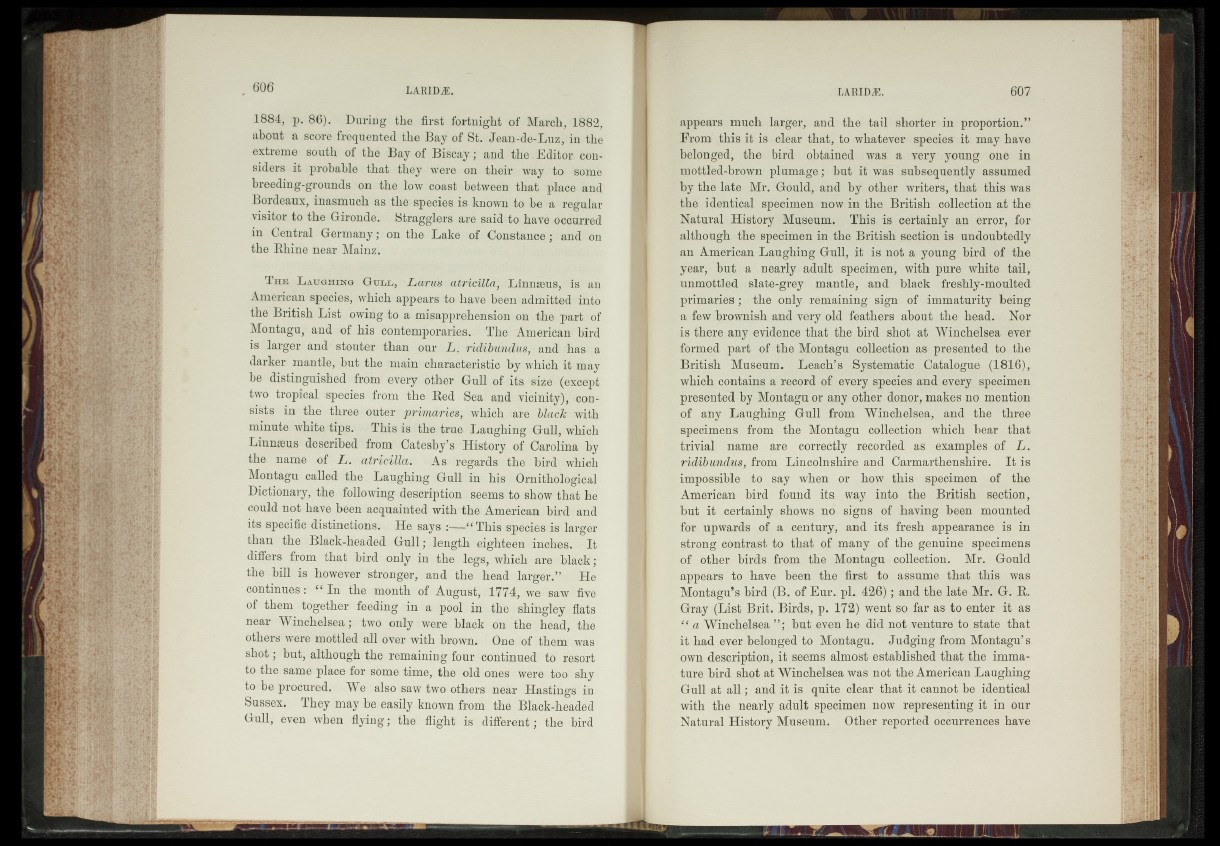
1884, p. 86). ’ During the first fortnight of March, 1882,
about a score frequented the Bay of St. Jean-de-Luz, in-the
extreme south of the Bay of Biscay; and the .Editor» considers
it probable that they were on their way; tor some
breeding-grounds on the low coast between that place and
Bordeaux, inasmuch as the species is known to be Ai regular
•visitor to the Gironde. Stragglers are said-to have occurred
in Central Germany; on the Lake of Constance; and on
the Rhine near Mainz i
T h e L aughing G ul l , L otus a ir ie illa '.rLi-nnseus, is an
American species, -which appears to have hêénAdmitted into
the British List owing to a misapprehension, on the- part; of
Montagu, and of his contemporaries. The. American" bird
is larger and stouter than our L. Tidibundiêêf? and has a
darker mantle, but the main -charkcteristic - by Whieh it- may
be distinguished from-every: other Gull Of its size1 ^(eösêpt
two tropic^species' from the Red Sea? and viöinity^/ïOO'n-
sistsi-in the three outer ; primaries, which saie/5i®uii with
minute white tips. This is the true Laughing Gull, which
Linnaeus described from CateSbyV History of Carolina: by
the name of L . r&trimllat '-As regards|fthe’;bird;-Which
Montagu called tthe; Laughing-Gulh in his\ Ornithological
Dictionary, the following description seems to- showhhat he
CEOuld not have been acquainted with'the American bird and
its specific distinctions. - He says-*^-r-£^ljiM&::,spebiesas larger
than the Black-headed Gull,; 'length •eighteenMneb'es.; It
differs from that bird only in the, legs-/which--ar.e black;
the bill is however stronger/ and the head largeiv’Vi'He
continues: “ In the month-of Augusty.fl774, we' sawlfivé
them together feeding ;an-i a pool in ^the v-shihgleyi flats
near Winchelsea; only: were black, on the v bead jfthe
others were mottled all-over with-brbwn. i#$ggiof - them was
shot; but, although the remaining fouiiJcontinued; to resort
to the same place for some: time, the old ones. wereofo®: shy
to be procured:. We also saw two-others near Hastings; in
Sussex. They may-bo easily known from the Black-headed
Gull,- even when flying; the -flight* is different; 'the -bird
appeara much larger, and the tail shorter in proportion.”:
From this it is clear that, to whatever species it. may have
belonged-, the'bird obtained was a very young one :in
mbttledrbrown plumage; but it was subsequently assumed
by the-late Mr. Gould, and . by. other writers, that this was
the identical specimen now in the British .collection at the
Natural History Museum. • This is certainly an error, for
although the specimen in the British section-is undoubtedly
an American Laughing Gull, it is not a young bird of the
year, but a nearly adult specimen, with pure white tail,
unmottled v,slate-grey mantle; and black freshly-moulted
primaries; the only remaining sign of -immaturity being
a few brownish and-woryold feathers about,the head. Nor
%s there, any evidence that the bird shot at Winchelsea ever
formed part of thee^ontagu o^H^t^i^as presented'1tpf4he
British Museum. Leach’s Systematic . Catalogue- (1816 ||
which contains a record of every species and every specimen
presented by Montagu^ any other donor,'makes no mention,
"Of, any Laughing Gull' from Winchellea," and the three
specimens from the Montagu collection which bear that
trivial name are correctly recorded as examples of L .
Iridibundus, from Lincolnshire and Carmarthenshire. It is
ImnosHible Mte sav^when.. or how this specimen of the
^American bird found its way into-, the British section,
but it certainly -shows po signs of having been mounted
-for upwards of^a c^n%qry, and its; fresh appearance is in
strong. con-tra#Kto that of many of the ,genuine specimens
of other birds from the Montagu ^p|]oqt|pn, Mr.. Gould
appears to, have been the first to .assume that 'this was
Montagu’s bird (B. of JEur.. ph 426); and the late Mr, G. R.
Gray Birds, p. 172)'went so far as,.to enter it as
“ a Winchelsea ” ; but even he 4id..not venture testate., that
it had ever belonged to MontaguJR|rudging from Montagu’s
own description,, it seems almost established that the immature
bird shot at Winchelsea was not the American Laughing
Gull-at a ll; and it is quite clear that it cannot be identical
with the nearly adult specimen now representing it j® pur
?Na,tural History Museum. Other:reppr-|eLoccui;rences have